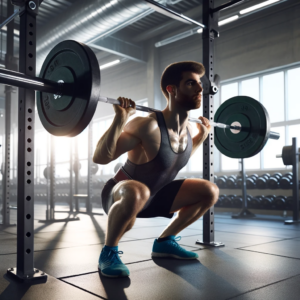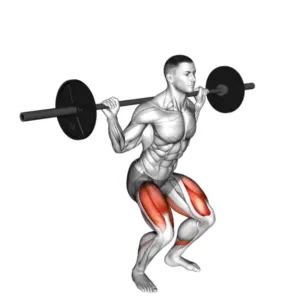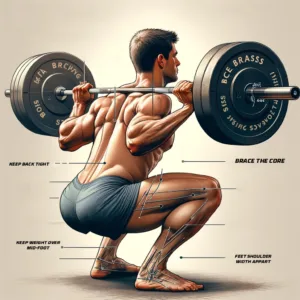 Back squatting is a fundamental exercise for athletes, providing an array of benefits crucial for enhancing athletic performance. Primarily, it develops lower body strength, crucial for power generation in many sports. This strength is foundational for improving speed, agility, and jump height, making athletes more competitive and dynamic in their movements. Additionally, back squatting promotes symmetry and balance, reducing the risk of injury by evenly strengthening both sides of the body. It also engages core muscles, improving stability and posture, which are vital for maintaining form and efficiency in athletic movements. Importantly, the exercise also enhances bone density and joint health, providing long-term benefits and resilience against wear and tear. This combination of strength, balance, and injury prevention makes back squatting an indispensable part of an athlete's training regimen.
Back squatting is a fundamental exercise for athletes, providing an array of benefits crucial for enhancing athletic performance. Primarily, it develops lower body strength, crucial for power generation in many sports. This strength is foundational for improving speed, agility, and jump height, making athletes more competitive and dynamic in their movements. Additionally, back squatting promotes symmetry and balance, reducing the risk of injury by evenly strengthening both sides of the body. It also engages core muscles, improving stability and posture, which are vital for maintaining form and efficiency in athletic movements. Importantly, the exercise also enhances bone density and joint health, providing long-term benefits and resilience against wear and tear. This combination of strength, balance, and injury prevention makes back squatting an indispensable part of an athlete's training regimen.
Pitching at high velocities requires a tremendous amount of force production. The best athletes, and especially, pitchers, understand that most of the power developed by an athlete is generated from the ground via the lower-half. Therefore, it stands to reason that one of the fundamental ways in which athletes can enhance their force production is by becoming stronger in lifts that tax the lower-body and force them to adapt to the new stimulus. That is why squatting plays a pivotal role in any good exercise program developed for athletes. Another benefit is the coordination required to execute a perfect squat. The squat not only demands that an athlete be as efficient as possible, but the mechanics of the squat very closely mimic the loading phase of the pitching delivery. This means the more stability and strength you can build through deep squatting, the more stable and powerful your pitching delivery will be which translates to an increase in pitching velocity and reduction in injury because now you are better able to channel the power from the ground up and not force your arm to over work.
An in-depth look at deep squats
While the depth that an individual player is largely determined by their anatomy, it is advisable to squat as deep as possible to see a greater transition of power to your pitching delivery. Some common causes that often restrict athletes from developing their squat potential are lack of ankle dorsiflexion, restricted hip mobility, lack of core stability, and lack of motor coordination skill. However, these issues should not stop you from trying to enhance your squat. These restrictions mentioned are able to be addressed through soft-tissue and joint mobilization for the ankle and hip mobility restrictions, and a good core routine to address the core weakness. Later in this article I will dive into how to develop better motor coordination in the squat with a few simple tips to help you better understand the sequencing of the squat. An important thing to understand is that no matter how strong and stable a core you may have, if your hips are restricted no amount of stability will be of benefit to getting a deeper squat. So, it is imperative that you focus on cleaning up any mobility restrictions you may to unlock the power of the deep squat.
Stability in the deep squat 
In the past, there was a widespread belief among experts that focusing solely on activating the transverse abdominis – a relatively small, flat muscle across the core – was the key to core stability. However, this approach is now understood to be somewhat misguided. As I've studied and observed in my work with athletes, the transverse abdominis is just one part of a larger "abdominal team." To truly support the lower back and enhance overall performance, it's crucial to engage all the core muscles in a balanced manner. This holistic activation is what provides the necessary stability and strength athletes need for optimal performance. It's not about isolating one muscle, but rather about working them all in harmony.
Based on research done by Peter O’Sullivan and Dr. Stuart McGill, it has been established that the best way to enhance core stability works in three phases. The first phase focuses on developing our overall perception of stability. Athletes need to actively feel the muscles contracting and working together to be able to maximize core stiffness, not simply brace and go. This may work if one is a seasoned lifter, but those just starting, or intermediates need to focus more on the fundamentals of the lifts so as not to be just going through the motions. Rushing the fundamentals will only lead to inefficient lifts and injury in the long term.
Phase two focuses on maintaining stability while performing functional movements. It is not uncommon to see people with tremendous core strength lose their perception of core stiffness as soon as they move. The great part about these functional core exercises is that they can be performed daily without worry of over taxing the muscles. These exercises are meant to help with the mind muscle connection not to develop a six pack. Although, as you progress and establish a better mind muscle connection, you will be able to perform better throughout your lifts which will help you better develop your six-pack if that is your end goal.
Benefits:
- Core Stability: It engages both the abdominal and back muscles, requiring them to work in tandem to stabilize the spine. This helps to improve overall core strength and stability, which is essential for good posture and injury prevention.
- Spinal Health: By promoting a neutral spine position during the exercise, it helps in reducing stress on the lower back, which can alleviate and prevent back pain.
- Improved Balance and Coordination: The Bird Dog exercise challenges your balance and coordination, as it requires you to extend opposite limbs while maintaining stability.
- Enhanced Body Awareness: This exercise improves proprioception, which is the awareness of the position and movement of the body, improving movement control and efficiency.
- Muscular Endurance: It can help increase endurance in the core muscles, which is beneficial for performing daily activities as well as sports and other forms of physical exercise.
- Lower Body Strength: While the focus is on the core, the Bird Dog also engages the glutes and hamstrings, contributing to lower body strength.
- Shoulder Stability: As one arm is lifted and extended, the shoulders are engaged, thus improving shoulder stability and strength.
- Versatility and Accessibility: It can be easily modified to match different fitness levels and requires no equipment, making it accessible to a wide range of individuals.
- Injury Rehabilitation and Prevention: Often used in rehab settings to help restore function to the spine and core muscles after injury.
- Preparation for Complex Movements: It prepares the body for more complex movements that require core strength and stability, like the squat or deadlift.
The third and final phase of the learning process is learning core stability within exercises performed with a specific sport in mind. A good exercise for this is the zombie squat. This exercise forces you to maintain the bars position over mid-foot otherwise the bar will roll off the shoulders and you will be unable to complete the lift.
Benefits:
- Core Strength and Stability: With no hands to stabilize the bar, the core must work harder to keep the torso upright and balanced.
- Upper Back and Shoulder Positioning: Promotes a good rack position by forcing the lifter to keep the elbows high, which is crucial in front squats and clean movements.
- Balance and Coordination: Enhances proprioception and body awareness, as the athlete must balance the bar without the use of their hands.
Establishing a baseline for Baseball
Now that we have addressed the restrictions that prevented you from performing the perfect squat, it's time to for you to establish a baseline from which you can progress you newly mastered squat technique so that you can maximize your development as a baseball athlete. A good place to start is by establishing your one-rep max for the lift. In the first couple of weeks your max may increase rapidly so it is good to test it every four weeks.
To establish your baseline, you can take a weight you typically do for 8-10 reps and go until failure. Then take the number of reps and weight you performed with and put it in to our one rep max calculator. With the Top Velocity Extreme program, all the hard work is done for you through our app which automatically sets the weight and reps for you so that you know exactly how many reps and sets you are supposed to be doing for each workout.
Maximizing squat performance for Baseball
If you want further help in perfecting your squat to maximize your baseball performance then you need to be learning the Top Velocity methods. Come attend our internationally known 3X velocity Camp and get one on one coaching to help you perform at your best for every lift and maximize your athletic prowess both in the weight room and on the field.

References
- O’Sullivan, P.B., 2000. Lumbar segmental ‘instability’: clinical presentation and specific stabilizing exercise management. Man. Ther. 5 (1), 2e12.
- Grenier SG & McGill SM. Quantification of lumbar stability by using 2 different abdominal activation strategies. Arch Phys Med Rehabil. 2007; 88:54-62
Other Resources
The Back Squat: Step-by-Step Guide - TopVelocity
Does squatting increase pitching velocity? - TopVelocity






